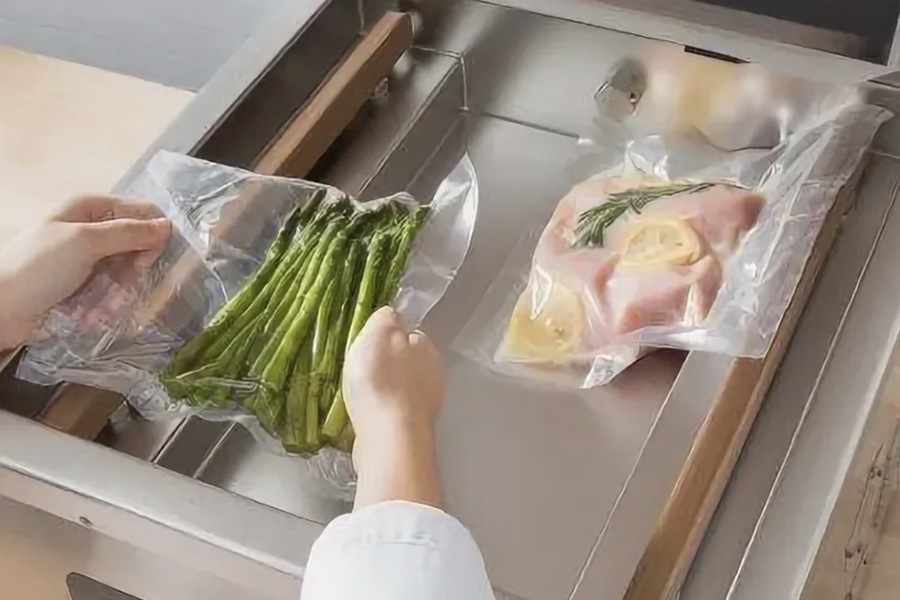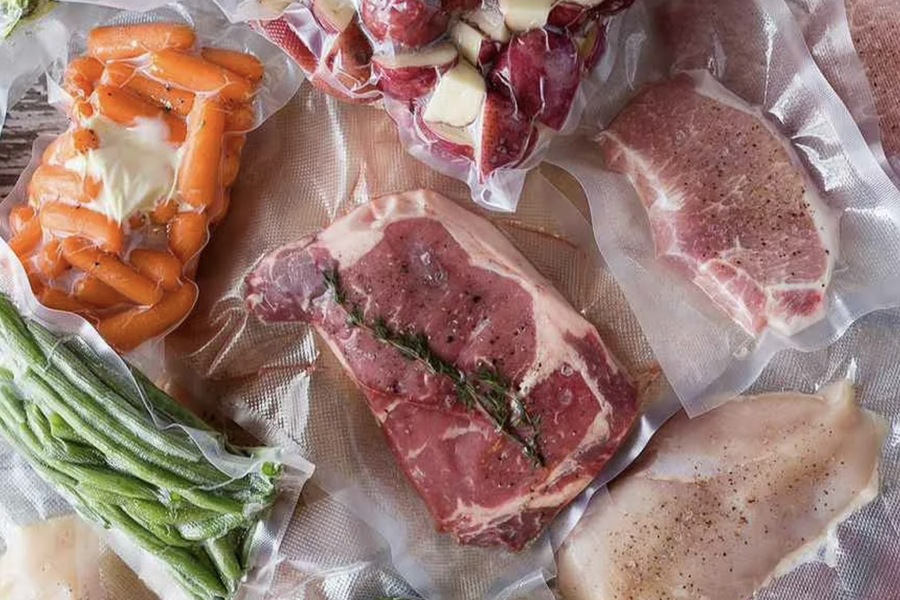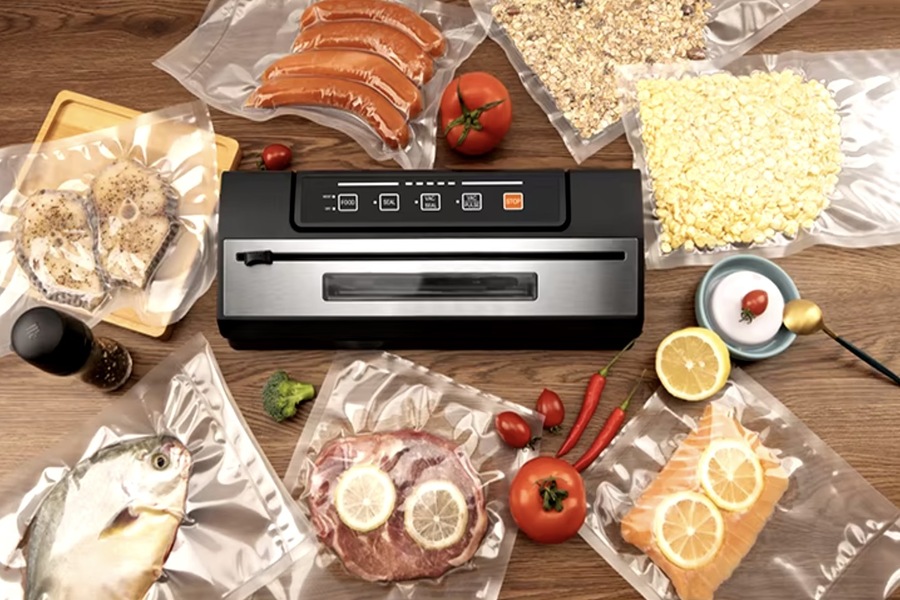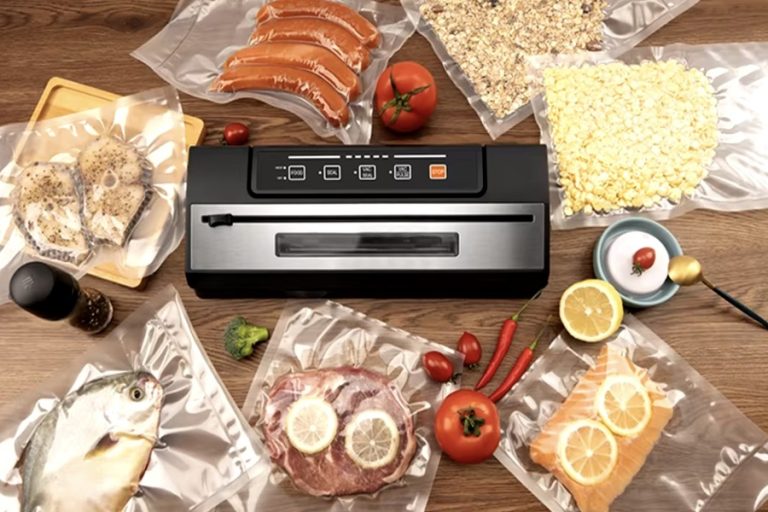Vacuum packing has revolutionized the way food is stored, both in home kitchens and commercial establishments. At its core, a vacuum packer is a device that removes air from a bag or container holding food, effectively creating a vacuum. This process preserves the freshness of a variety of foods for significantly longer periods than traditional storage methods. Foods such as fresh or frozen semi-finished products, meats, fish, fruits, vegetables, herbs, mushrooms, cheeses, and even ready-to-eat meals can benefit from vacuum sealing. For those seeking top-quality equipment, Kitchen Warehouse offers a wide range of vacuum packers, perfect for preserving food at home or in professional kitchens.
In the absence of air, food is protected from oxidation, moisture, and the growth of bacteria and mold. As a result, vacuum-sealed food remains fresh, flavorful, and retains its natural color for much longer than food stored in regular containers or bags. Whether it’s for home use, catering services, or food production facilities, vacuum packing is now a widely used method to ensure food quality and longevity.
The Benefits of Vacuum Packaging
Vacuum packaging offers several advantages, not only in preserving the freshness of food but also in improving storage efficiency, reducing waste, and preventing contamination.
1. Extended Shelf Life
The most significant benefit of vacuum packaging is its ability to prolong the shelf life of food. Without air, food is not exposed to oxygen, which causes the oxidation process that leads to spoilage. As a result, oxidation and the growth of harmful bacteria are dramatically slowed down, extending the lifespan of food by 2 to 5 times. This is especially important for products like fresh meat, fish, cheese, and deli items, which have a short shelf life when exposed to air.
2. Preservation of Freshness and Appearance
In a vacuum-sealed package, food maintains its original appearance and texture for a longer period. It doesn’t dry out or lose its natural moisture, which helps preserve the vibrant color and texture of the food. This is particularly important in retail environments where food is displayed in store shelves and needs to remain visually appealing to consumers. The fact that vacuum-sealed products do not absorb external odors ensures that they retain their unique aromas and flavors.
For example, when vacuum-sealed, fresh fruits and vegetables retain their crispness and color, while meat products like steaks remain juicy and red, free from freezer burn. Moreover, cheese and sausages retain their firmness and flavor without exposure to drying air or moisture.
3. Protection from Moisture and Foreign Odors
A vacuum-sealed package provides an airtight barrier that protects food from external moisture. This is especially important for foods sensitive to humidity, such as grains, flour, pasta, and nuts. For instance, flour, when exposed to moisture, can clump or develop mold, whereas vacuum-sealed flour stays dry and usable for months.
In addition, vacuum-packed food does not absorb foreign odors from other foods stored nearby. This means that strong-smelling foods like smoked fish, garlic, or cheese can be stored next to milder foods such as bread or cakes without affecting their flavor or aroma.
4. Efficient Freezing and Defrosting
Vacuum packing offers significant advantages when it comes to freezing and defrosting food. Freezing food in vacuum-sealed packages prevents the formation of ice crystals, which can damage the structure of the food. For instance, when vacuum-sealed meat is frozen, the absence of air ensures that the meat fibers remain intact, preserving the meat’s natural texture. Additionally, the compact nature of vacuum-sealed packages helps save space in freezers, making it easier to organize and store multiple items.
When it comes to defrosting, vacuum-packed food retains its original texture and moisture without freezer burn or loss of quality. As a result, vacuum-sealed meat, fish, or vegetables defrost quickly and uniformly, allowing for faster meal preparation without compromising quality.
5. Protection Against Pests
Vacuum-sealed packaging is also effective at protecting food from insects and other pests. Sealed packaging prevents pests like ants, flies, and moths from accessing food, which is especially important in warmer climates or areas where pests are more prevalent. This makes vacuum packaging particularly useful for storing grains, dried fruits, nuts, and seeds, as well as bulk items in kitchens or pantries.
6. Portion Control and Packaging
Another key benefit of vacuum packing is that it allows for precise portion control. This is especially useful in the food industry, where items are packed according to specific weights or sizes for retail sale. Pre-portioned vacuum-sealed bags make meal preparation more convenient for consumers, as they can quickly select the right amount of food without the need for measuring or repacking.
In catering or restaurant settings, vacuum sealing also helps chefs prepare ingredients ahead of time, portioned out according to recipe requirements. This not only speeds up kitchen operations but also minimizes food waste, as food can be stored for longer periods without spoiling.

Types of Vacuum Packers
Depending on the intended use, there are three main types of vacuum packers available: manual, chamberless (aspiration), and chamber vacuum packers.
1. Manual Vacuum Packers
Manual vacuum packers are portable, easy-to-use devices, making them ideal for home use. These devices work on the principle of a pump and are designed to remove air from containers or bags manually. They are perfect for preparing homemade food portions, packing products for travel, or preserving leftovers.
While not as powerful as their commercial counterparts, manual vacuum packers are affordable, compact, and great for everyday use. They are particularly helpful in preserving foods like cheese, cooked meats, and vegetables.
2. Chamberless (Aspiration) Vacuum Packers
Chamberless vacuum packers are small, compact machines designed for moderate use in retail or food service establishments. They can vacuum-seal a wide variety of food items in both containers and bags. One of the main advantages of chamberless packers is their higher productivity, making them suitable for small grocery stores, delis, or restaurants. They are also more versatile than manual packers, as they can handle a wider range of food sizes and shapes.
3. Chamber Vacuum Packers
Chamber vacuum packers are powerful, high-performance devices designed for industrial use. They feature one or two vacuum chambers and are capable of vacuum-sealing both solid and liquid foods, including soups, sauces, and marinades. These machines are widely used in food manufacturing plants to package large quantities of food for sale in supermarkets or catering establishments.
Chamber packers also allow the use of a variety of bag types, including smooth bags, which are typically more affordable than the ribbed bags required for chamberless machines.

Key Components of a Vacuum Packer
Body Construction
The body of a vacuum packer is typically made from durable materials like plastic, aluminum, or stainless steel, which house the vacuum pump and other essential components.
Vacuum Pump
This is the core of the device, responsible for extracting air from the packaging to create a vacuum environment.
Sealing Strip
After the air is removed, the bag is sealed shut by a heating element that melts the bag’s edges, creating an airtight seal.
Air Valve
Commonly found in chamberless vacuum packers, the air valve allows air to be expelled from the packaging as the vacuum pump operates.
Control Panel
Most modern vacuum packers feature a control panel with buttons and displays for adjusting the settings and monitoring the vacuum-sealing process.
Conclusion
The benefits of vacuum packing go far beyond simple food preservation. By eliminating air from the packaging, vacuum packers help extend the shelf life of food, maintain its freshness and quality, and protect it from external contaminants like moisture, odors, and pests. Whether for home use, retail environments, or industrial food production, vacuum packaging has become a critical technology in modern food storage.
In the UAE, reliable vacuum-packing equipment can be found at competitive prices. For example, the Electrolux Vacuum Packaging Machine, available at Kitchen Warehouse for 9,975.00 AED, offers advanced functionality for preserving food efficiently, making it an ideal choice for both home kitchens and commercial food operations.

Skier, traveler, music blogger, hand letterer and HTML & CSS lover. Performing at the sweet spot between art and purpose to craft delightful brand experiences. German award-winning designer raised in Austria & currently living in New York City.








